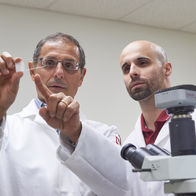Silvia Fossati, PhD
Interim Director and Associate Professor, Alzheimer's Center at Temple
Associate Professor, Neural Sciences
Associate Professor, Cardiovascular Sciences
Associate Professor, Lemole Center for Integrated Lymphatics and Vascular Research

- Contact Information
-
- About Me
-
Research Interests
The research in my lab focuses on the molecular pathogenesis of cerebrovascular disorders and the cell-death mechanisms underlying neurodegeneration in Alzheimer’s disease (AD), cerebral amyloid angiopathy (CAA), traumatic brain injury (TBI), and post-traumatic stress disorder (PTSD).
We analyze the effects of cellular oxidative and mitochondrial stress, apoptosis, and inflammation and explore pharmacological compounds capable of inhibiting these events. Also, we are actively searching for novel diagnostic biofluid biomarkers for AD, TBI, PTSD.
My interests have recently centered on how different amyloid aggregation species modulate molecular mechanisms and signaling pathways that trigger cell toxicity and cell stress responses in AD and CAA. In particular, we are focusing on mitochondrial dysfunction in cells comprising the neurovascular unit and in neuronal and glial cells.
We are deeply interested in the effects of amyloid variants on endothelial cell death and blood–brain barrier permeability, as well as the contribution of mitochondria, death receptors, and inflammation mediators in these events. By applying biochemical, molecular, and imaging techniques in cultured cells, animal models, and human AD or CAA brain neurovascular cells, we identified the tumor necrosis factor-related apoptosis-inducing ligand (TRAIL) death receptors, DR4 and DR5, as targets for amyloid beta oligomers, which are responsible for the initiation of mitochondrial apoptosis in brain vascular cells.
Currently, we are studying the protective effects of carbonic anhydrase inhibitors against mitochondrial failure in amyloid-challenged cells and animal models. Our ongoing studies also explore the interactions between AD, cerebral amyloidosis, and cardiovascular risk, as well as between tau pathology and TBI and their combined effects on mitochondrial dysfunction and neurovascular cell death. Our goals are twofold: to unveil new drug development targets that can protect brain neuronal and vascular cells against neurodegeneration, cerebral hypoperfusion, and hemorrhage, and to discover new biomarkers for these diseases.
- Education, Training & Credentials
-
Educational Background
- Postdoctoral Fellowship, Pathology, NYU School of Medicine, New York, NY
- PhD, Pharmacology and Toxicology, University of Florence, Italy
- Research Fellowship, Pharmacology, University of Florence, Italy
- BS, Molecular Biology, University of Florence, Italy
Memberships
- Society for Neuroscience
- International Society to Advance Alzheimer’s Research and Treatment (ISTAART)
- American Heart Association
- Italian Scientists and Scholars in North America Foundation (ISSNAF)
- Vas-Cog Society: The international society of vascular behavioral and cognitive disorders
- Grant Reviewer for The Alzheimer’s Association, Chicago, IL
- Grant Reviewer for The Italian Ministry of Health, the Swedish Research Council, the Medical Research Council (UK), the American Institute of Biological Sciences, the Alzheimer’s Society UK
- Grant Reviewer for the National Institutes of Health (NIH)
- Grant Reviewer for US Department of Defense
- Biomarker Professional Interest Area (PIA) and Biofluid Biomarker Reference Ranges Working Group for the Alzheimer’s Association
- Vascular PIA and working group on White Matter Lesions for the Alzheimer’s Association
- US Department of Defense CDMRP PRARP Study Section
Honors & Awards
- Leon Levy Fellowship in Neuroscience, 2016
- Director of the Biofluid Biomarkers Core of the Cohen Veteran Center, NYULMC Department of Psychiatry, 2015-19
- Blas Frangione Foundation New Investigator Research Grant, 2014
- Scientist Development Grant Award (2013-2017) from the American Heart Association, 2013
- New Investigator Research Grant Award from the Alzheimer’s Association, 2012
- NYU Alzheimer’s Disease Center Pilot Grant, Center of Excellence on Brain Aging, NYU Langone Medical Center, 2010
- Publications
-
Digital Bibliography
Additional Publications
1. S. Fossati*, E. Rapizzi*, F. Moroni, A. Chiarugi. Inhibition of poly(ADP-ribose) glycohydrolase by gallotannin selectively up-regulates expression of proinflammatory genes. Mol Pharmacol. 2004; 66(4):890-8.
2. A. Cozzi, G. Cipriani, S. Fossati, G. Faraco, L. Formentini, W. Min, U. Cortes, Z.Q. Wang, F. Moroni, A. Chiarugi. Poly(ADP-ribose) accumulation and enhancement of postischemic brain damage in 110-kDa poly(ADP-ribose) glycohydrolase null mice. J Cereb Blood Flow Metab. 2006; 26(5):684-95.
3. S. Fossati , L. Formentini, Z.Q. Wang, F. Moroni and A. Chiarugi. Poly (ADP-ribosyl)ation regulates heat shock factor-1 activity and the heat shock response in murine fibroblasts. Biochem Cell Biol., 2006; 84(5):703-12.
4. S. Fossati, G. Cipriani, F. Moroni, A. Chiarugi. Neither energy collapse nor transcription underlie in vitro neurotoxicity of poly(ADP-ribose) polymerase hyper-activation. Neurochem Int., 2006, 50(1), 203-10.
5. M. Porcu, F. Guarna, L. Formentini, G. Faraco, S. Fossati, R. Mencucci, E. Rapizzi, U.Menchini, F. Moroni and A. Chiarugi. Carboxymethyl β-glucan binds to corneal epithelial cells and increases cell adhesion to laminin and resistance to oxidative stress. Cornea, 2007, 26(1), 73-9.
6. S. Fossati and A. Chiarugi. Relevance of High Mobility Group Protein Box 1 (HMGB1) to neurodegeneration. Int. Rev. Neurobiol, 2007;82:137-48. DOI: 10.1016/S0074-7742(07)82007-1.
7. A. Aldinucci, G. Gerlini, S. Fossati, G. Cipriani, C. Ballerini, T. Biagioli, N. Pimpinelli, L. Borgognoni, L. Massacesi, F. Moroni and A. Chiarugi. Requirement for PARP-1 activity during human dendritic cell maturation. J. Immunol., 2007 1;179(1):305-12.
8. S. Fossati*, G. Faraco*, M.E. Bianchi, M. Patrone, M. Pedrazzi, B. Sparatore, F. Moroni and A.Chiarugi. High Mobility Group Box 1 Protein is released by neural cells upon different stresses and worsens ischemic neurodegeneration in vitro and in vivo. J. Neurochem. 2007;103(2):590-603.
9. Solito R., Corti F., Fossati S., Mezhericher E., Donnini S., Ghiso J., Giachetti A., Rostagno A. and Ziche M. Dutch and Arctic mutant peptides of β amyloid 1-40 differentially affect the FGF-2 pathway in brain endothelium. Exp Cell Research 315, 2009: 385–395.
10. R. J. S. Viana, A. F. Nunes, R. E. Castro, R.M. Ramalho, J. Meyerson, S. Fossati, J. Ghiso, c, A. Rostagno and C. M. P. Rodrigues. Tauroursodeoxycholic acid prevents E22Q Alzheimer’s Aβ toxicity in human cerebral endothelial cells. Cell Mol Life Sci. 2009; 66(6):1094-104.
11. Faraco G, Pittelli M, Cavone L, Fossati S, Porcu M, Mascagni P, Fossati G, Moroni F, Chiarugi A. Histone deacetylase (HDAC) inhibitors reduce the glial inflammatory response in vitro and in vivo. Neurobiol Dis. 2009; 36(2):269-79.
12. Fossati S, Cam J, Meyerson J, Mezhericher E, Romero IA, Couraud PO, Weksler BB, Ghiso J, Rostagno A. Differential activation of mitochondrial apoptotic pathways by vasculotropic amyloid-β variants in cells composing the cerebral vessel walls. FASEB J. 2010; 24(1):229-41.
13. Hernandez-Guillamon M, Mawhirt S, Fossati S, Blais S, Pares M, Penalba A, Boada M, Couraud PO, Neubert TA, Montaner J, Ghiso J, Rostagno A. Matrix metalloproteinase 2 (MMP-2) degrades soluble vasculotropic amyloid-beta E22Q and L34V mutants, delaying their toxicity for human brain microvascular endothelial cells. J Biol Chem. 2010; 285(35):27144-58.
14. Fossati S, Ghiso J, Rostagno A. Molecular analysis of apoptotic pathways induced by amyloid-β variants in cerebral vascular cells. Alzheimer’s & Dementia, 2010; 6: S376-S377.
15. Rostagno A, Fossati S, Ghiso J. Fibrillogenesis and toxicity of Iowa-Aβ amyloid is primarily driven by the D23 mutation. Alzheimer’s & Dementia, 2010; 6: S242.
16. Fossati S., Ghiso J., Rostagno A. Insights into caspase-mediated apoptotic pathways induced by amyloid-β in cerebral microvascular endothelial cells. Neurodegenerative Diseases 10, 324-328 (2012). SF Corresponding Author.
17. Fossati S., Ghiso J & Rostagno A. TRAIL death receptors DR4 and DR5 mediate cerebral microvascular endothelial cell apoptosis induced by oligomeric Alzheimer’s Aβ. Cell Death and Disease. 2012 Jun 14;3:e321. doi: 10.1038/cddis.2012.55
18. Fossati, S; Ghiso, J; Rostagno, A Amyloid beta oligomers trigger death receptors-mediated apoptosis in cerebral endothelial cells. FASEB journal. 2012:26. ISSN: 0892-6638
19. Fossati S*, Todd K*, Sotolongo K., Ghiso J, Rostagno A. Differential contribution of isoaspartate post-translational modifications to the fibrillization and toxic properties of amyloid β and the Asn23 Iowa mutation. Biochem J. 2013 Dec 15;456(3):347-60. doi: 10.1042/BJ20130652.
20. S Fossati, P Giannoni, M Hernandez-Guillamon, J Montaner, J Ghiso, A. Rostagno. Mitochondria and death receptors: Key targets for amyloid toxicity in the cerebral vasculature. Alzheimer's & Dementia: The Journal of the Alzheimer's Association 2014-10 (4), P191.
21. Todd K.; Fossati S.; Ghiso J.; Rostagno A. Mitochondrial dysfunction induced by a post-translationally modified amyloid linked to a familial mutation in an alternative model of neurodegeneration. Biochim Biophys Acta. - Molecular Basis of Disease 2014 Sep 28. pii: S0925-4439(14)00291-9. doi: 10.1016/j.bbadis.2014.09.010.
22. Ghiso, J; Fossati, S; Rostagno, A. Amyloidosis associated with cerebral amyloid angiopathy: Cell signaling pathways elicited in cerebral endothelial cells 2014-04-09; 1387-2877, Journal of Alzheimer's Disease - id: 871452, year: 2014.
23. Fossati, S; Giannoni, P; Solesio, M; Del, Mar Hernandez M; Ghiso, J; Rostagno, A. Death receptors and mitochondria as crucial targets for drug discovery in cerebral amyloid angiopathy. 2015-04-10; 0039-2499, Stroke - id: 1522242, year: 2015.
24. S Fossati, P Giannoni, M Solesio, S Cocklin, E Cabrera, J Ghiso, A Rostagno. Methazolamide protects neuronal and glial cells from amyloid toxicity in vitro and in vivo via mitochondria-mediated mechanisms. Alzheimer's & Dementia 2015 11(7):P860-P861 (# 1923902).
25. J Spiegel, E Pirraglia, Y Li, W Tsui, L Glodzik, R Osorio, L A. Saint Louis, C Randall, T Butler, J Xu, R P Zinkowski, H Zetterberg, J Fortea, S Fossati, T Wisniewski, P Davies, K Blennow, M J de Leon. Greater specificity for CSF P-tau231 over P-tau181 in the differentiation of healthy controls from Alzheimer’s. J Alzheimers Dis. 2015 Sep 28;49(1):93-100. doi: 10.3233/JAD-150167
26. S Fossati, P Giannoni, M E. Solesio, S L. Cocklin, E Cabrera, J Ghiso and A Rostagno. The carbonic anhydrase inhibitor methazolamide prevents amyloid beta-induced mitochondrial dysfunction and caspase activation protecting neuronal and glial cells in vitro and in the mouse brain. Neurobiol Dis. 2016 Feb;86:29-40. doi: 10.1016/j.nbd.2015.11.006. SF Corresponding Author.
27. Fossati S. Commentary: The carbonic anhydrase inhibitor methazolamide prevents amyloid beta-induced mitochondrial dysfunction and caspase activation protecting neuronal and glial cells in vitro and in the mouse brain. World Biomedical Frontiers ISSN: 2328-0166, March 2016. http://biomedfrontiers.org/alzheimer-2016-3-8
28. Solesio ME Debure L. Pavlov E. Wisniewski T. Fossati S. Carbonic anhydrase is a crucial target for prevention of mitochondrial pathology in Alzheimer’s models. Alzheimer's & Dementia. July 2016. Volume 12, Issue 7, Supplement, Page P650 DOI: https://doi.org/10.1016/j.jalz.2016.06.1261
29. M.J. de Leon, Y. Li, N Okamura, W.H. Tsui , L.A. Saint-Louis, L. Glodzik, R.S. Osorio, J. Fortea, T. Butler, E. Pirraglia, S. Fossati, H-J Kim, R. O. Carare, M. Nedergaard, H. Benveniste, and H. Rusinek. CSF clearance in Alzheimer Disease measured with dynamic PET. J Nucl Med. 2017 Mar 16. pii: jnumed.116.187211. doi:10.2967/jnumed.116.187211. PMID: 28302766
30. Fossati S, Cejudo JR, Debure L, et al. Differential value of plasma tau as a biomarker for Alzheimer's disease and chronic traumatic brain injury. Alzheimers’ and Dementia. 2017 Jul;13(7):4-133. DOI: http://dx.doi.org/10.1016/j.jalz.2017.06.1999.
31. Mony J. de Leon, Elizabeth Pirraglia, Ricardo S. Osorio, Lidia Glodzik, Les Saint-Louis, Hee-Jin Kim, Juan Fortea, Silvia Fossati, Eugene Laska, Carole Siege, Tracy Butler, Yi Li, Henry Rusinek, Henrik Zetterberg, Kaj Blennow. The nonlinear relationship between cerebrospinal fluid Aβ42 and Tau in preclinical Alzheimer’s disease. PLoS One. 2018 Feb 7;13(2):e0191240. doi: 10.1371/journal.pone.0191240. eCollection 2018.
32. Jaime Ramos-Cejudo, Thomas Wisniewski, Charles Marmar, Henrik Zetterberg, Kaj Blennow, Mony J. de Leon, Silvia Fossati. Traumatic Brain Injury and Alzheimer's Disease: The Cerebrovascular Link. EBioMedicine (Lancet and Cell new Open Access Journal) 2018 Jan 30. pii: S2352-3964(18)30025-2. doi: 10.1016/j.ebiom.2018.01.021.
33. Solesio María E, Peixoto Pablo Debure Ludovic, Madamba Stephen M, de Leon Mony J, Wisniewski Thomas, Pavlov Evgeny and Fossati Silvia. Carbonic Anhydrase Inhibition Selectively Prevents Amyloid β Neurovascular Mitochondrial Toxicity. Aging Cell. 2018 Jun 5:e12787. doi: 10.1111/acel.12787.
34. Silvia Fossati, Jaime Ramos Cejudo, Afia Genfi, Duna Abu-Amara, Charles Marmar Discovery of Novel Blood Biomarkers for PTSD and TBI. Biological Psychiatry 2018, Volume 83, Issue 9, Supplement, Pages S134–S135. DOI: https://doi.org/10.1016/j.biopsych.2018.02.352
35. A Etkin, G A. Fonzo, W Wu, J Huemer, B Patenaude, P E. Vértes, J Richiardi, MS. Goodkind, CJ. Keller, J Ramos Cejudo, YV. Zaiko, KK. Peng, E Shpigel, P Longwell, RT. Toll, A Thompson, S Zack, B Gonzalez, R Edelstein, J Chen, I Akingbade, E Weiss, R Hart, S Mann, K Durkin, S Baete, F Boada, A Genfi, J Autea, J Newman, D J. Oathes, S E. Lindley, D Abu-Amara, B A. Arnow, N Crossley, J Hallmayer, S Fossati, B O. Rothbaum, CR. Marmar, ET. Bullmore, R O’Hara. Connectomics and cognition define a treatment-resistant form of post-traumatic stress disorder. Science Translational Medicine, 2018. In press.
36. Etkin A, Maron-Katz A, Wu W, Fonzo GA, Huemer J, Vértes PE, Patenaude B, Richiardi J, Goodkind MS, Keller CJ, Ramos-Cejudo J, Zaiko YV, Peng KK, Shpigel E, Longwell P, Toll RT, Thompson A, Zack S, Gonzalez B, Edelstein R, Chen J, Akingbade I, Weiss E, Hart R, Mann S, Durkin K, Baete SH, Boada FE, Genfi A, Autea J, Newman J, Oathes DJ, Lindley SE, Abu-Amara D, Arnow BA, Crossley N, Hallmayer J, Fossati S, Rothbaum BO, Marmar CR, Bullmore ET, O'Hara R. Using fMRI connectivity to define a treatment-resistant form of post-traumatic stress disorder. Sci Transl Med. 2019 Apr 3;11(486). pii: eaal3236. doi: 10.1126/scitranslmed.aal3236. PMID: 30944165


